|
WHAT KIND OF WHALES WILL WE SEE?
|
Whales commonly sighted off our coast are Humpbacks, "the singing whales",
ranging up to 50 feet in length; Finbacks, the second largest whale on
earth ranging up to 70 feet; Minke Whales, up to 20 feet in length; 50
foot Right Whales, the rarest whale in the North Atlantic and White - Sided
Dolphins. We have had surprise sightings of Sei Whales generally found
off Norway, the giant Blue Whale, the largest animal on earth, and in 1995
the Sperm Whale, generally found in the deep waters off the continental
shelf. Other species more commonly sighted on our trips are Pilot Whales,
Harbor and Gray Seals, Blue Sharks, the giant Basking Shark, Bluefin Tuna,
huge ocean Sunfish , and a variety of sea birds.
WHAT IS A WHALE? Whales are mammals like
horses, dogs and humans. All mammals have lungs, and breathe air, have
warm blood, bear their young live, and the females have mammary glands
which produce milk to feed their young. Most mammals also have legs and
hair or fur. Millions of years ago, whales evolved from land dwelling animals.
The skeletal structures of some whales still have traces of hind legs,
and some species of whale still have hair on the head. |
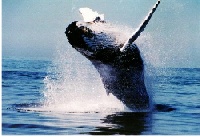
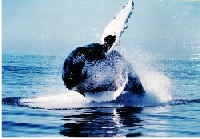
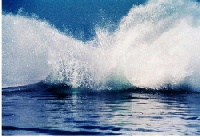
|
Over the centuries, as whales gradually moved
from the land to the sea, incredible adaptations in their anatomy occurred.
The muscles of the upper rear legs have become a powerful tail stock, enabling
some whales to swim at speeds of over 20 miles an hour. At the end of the
tail stock is a pair of horizontal "flukes" that propels the
whale forward by moving up and down. A whale's nostril, called a blow hole,
is located on the top of the head, so very little of the animal has to
surface to breathe. The blow hole is connected directly to the lungs, eliminating
mouth-breathing altogether. The forelimbs of whales are flippers of varying
length, with a bone structure similar to a human arm.
All Whales, Dolphins, and Porpoises belong to
the same order of mammals - the Cetaceans. Cetaceans are divided into two
major groups: the Odontocetes, or Toothed Whales, and the Mysticetes (from
the Greek word for "mustache"), or Baleen Whales. Odontocetes
comprise the Dolphins, Porpoises, Orca, and Sperm Whales. Mysticetes comprise
whales such as the Right Whale, Finback Whale, Minke Whale, Sei Whale,
Bowhead, and many people's favorite, the Humpback Whale.
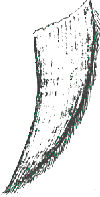
The structure of the feeding mechanisms in the
whales mouth determines the style and type of feed these whales hunt to
sustain themselves. One of many baleen plates that line the inside of the
mouths of mysticete whales is pictured at right. These baleen plates are used to
strain their food from the water. Whales have developed
many different feeding strategies and, when feed is abundant, many different
types of these strategies can be observed during one trip.
Education, Narration and Research
7 Seas Whale Watch is committed to contributing to the scientific
research of the whales off our coast. Thanks to the information gathered
by researchers on public whale watch vessels, the humpback whales off the
coast of Gloucester are the best known in the world. Data collected on
our cruises by researchers from the New England Whale Center. Whale watch vessels
provide a platform where information is gathered to aid in tracking the migration,
reproduction, and feeding habits of individual humpbacks that return year
after year. Each trip is fully narrated by one of the most experienced whale
researchers in the area. They are happy to be available to you during your trip.
Our naturalists have worked as scientists, ecologists, researchers, and ornithologists
in many of the world's oceans where whales are commonly found. You are with the best
in the field on our trips.
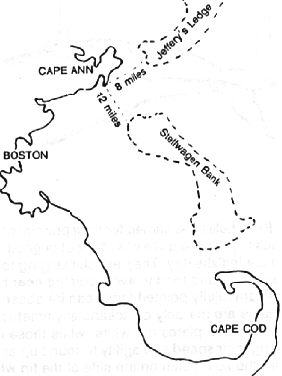 WHY
ARE THE WHALES HERE? We are very fortunate in Gloucester to be within
easy travel distance from two major feeding areas for the great whales
to come into to feed. One is Jefferey's Ledge, the other is Stellwagen
Bank. Many species of whales, especially Humpbacks, live a migratory life.
Their needs for food and giving birth require very different environments.
A newborn whale does not have a protective blubber layer and must have
warm water to survive its first few months of life. Therefore, the major
mating and calving grounds are located in southern oceans. In the warm
water there has less oxygen and therefore less plant growth and prey species
for food. So, adult whales, and whales with calves at least a few months
old, must migrate, traveling thousands of miles, to northern colder waters
where food is abundant. WHY
ARE THE WHALES HERE? We are very fortunate in Gloucester to be within
easy travel distance from two major feeding areas for the great whales
to come into to feed. One is Jefferey's Ledge, the other is Stellwagen
Bank. Many species of whales, especially Humpbacks, live a migratory life.
Their needs for food and giving birth require very different environments.
A newborn whale does not have a protective blubber layer and must have
warm water to survive its first few months of life. Therefore, the major
mating and calving grounds are located in southern oceans. In the warm
water there has less oxygen and therefore less plant growth and prey species
for food. So, adult whales, and whales with calves at least a few months
old, must migrate, traveling thousands of miles, to northern colder waters
where food is abundant.

|
|

 WHY
ARE THE WHALES HERE? We are very fortunate in Gloucester to be within
easy travel distance from two major feeding areas for the great whales
to come into to feed. One is Jefferey's Ledge, the other is Stellwagen
Bank. Many species of whales, especially Humpbacks, live a migratory life.
Their needs for food and giving birth require very different environments.
A newborn whale does not have a protective blubber layer and must have
warm water to survive its first few months of life. Therefore, the major
mating and calving grounds are located in southern oceans. In the warm
water there has less oxygen and therefore less plant growth and prey species
for food. So, adult whales, and whales with calves at least a few months
old, must migrate, traveling thousands of miles, to northern colder waters
where food is abundant.
WHY
ARE THE WHALES HERE? We are very fortunate in Gloucester to be within
easy travel distance from two major feeding areas for the great whales
to come into to feed. One is Jefferey's Ledge, the other is Stellwagen
Bank. Many species of whales, especially Humpbacks, live a migratory life.
Their needs for food and giving birth require very different environments.
A newborn whale does not have a protective blubber layer and must have
warm water to survive its first few months of life. Therefore, the major
mating and calving grounds are located in southern oceans. In the warm
water there has less oxygen and therefore less plant growth and prey species
for food. So, adult whales, and whales with calves at least a few months
old, must migrate, traveling thousands of miles, to northern colder waters
where food is abundant.
